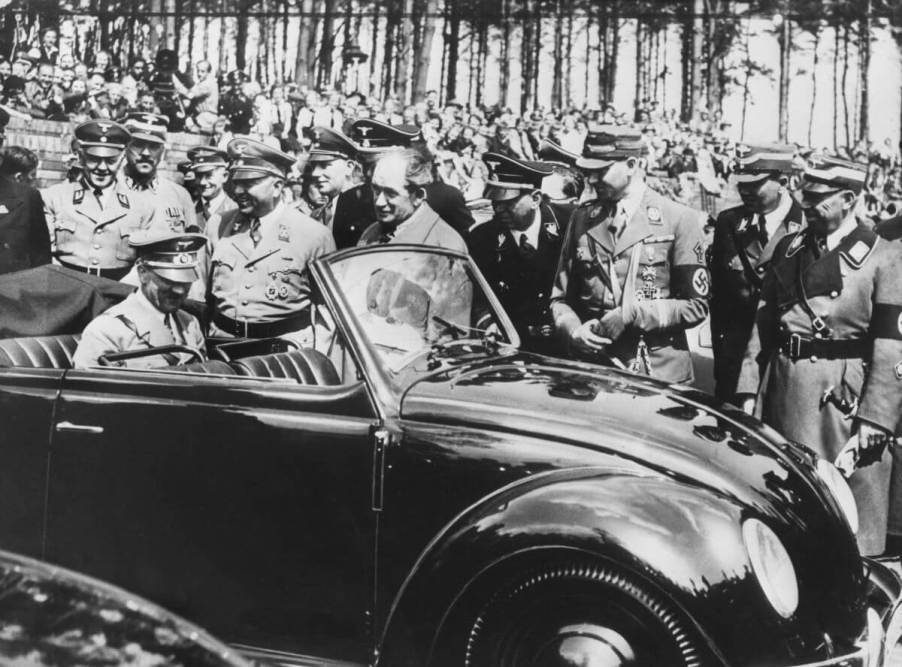
How Volkswagen and the Beetle Were Created by Nazi Germany
Volkswagen has a unique corporate history. The Wolfsburg-based conglomerate currently using that name, Volkswagen AG, is one of the world’s largest vehicle manufacturers, turning out cars under its own name as well as Audi, Bentley, Cupra, Jetta, Lamborghini, Porsche, SEAT, and Škoda, not to mention Ducati motorcycles and commercial vehicles under several more marques. That’s no small achievement for a company founded to produce just one car under instruction from the worst person in the world. Even the name “Volkswagen” – German for “the People’s Car” – attests to its origin. While the company has long since evolved beyond its fraught origin, it was founded less as a company than as a statement of the economic and cultural superiority of Nazi Germany.
Nazi Germany and the founding of Volkswagen
Per Volkswagen AG itself, “Gesellschaft zur Vorbereitung des Deutschen Volkswagens mbH” – shortening the marque to “Volkswagen” was probably smart branding – was founded in Berlin, Germany in 1937 as something very different from a conventional car company. The German Labor Front, an alliance of Nazi officials and collaborating corporate officers that handled Germany’s labor issues, founded the company on orders from Adolf Hitler himself. The company’s sole project was the titular Volkswagen, a simple, reliable set of wheels ready to motorize every good German in the Reich. Hitler put the legendary Ferdinand Porsche in charge of design, and the first “Porsche Model 60,” soon to be known worldwide as the Beetle, hit the German market in 1938.
Of course, keeping up with business obligations becomes more of a challenge when the boss invades Poland. Production of the original Beetle had barely begun in September 1939 when Nazi Germany began its planned conquest of Europe. The Volkswagen factory in Wolfsburg was converted to the war effort where, manned largely by slave labor, it would produce vehicles, weapons, and even the infamous V-1 rocket.
Germany’s economic plans after World War II
Like most of Germany, Volkswagen faced hard times in the postwar period. The Allies of World War II stopped being Allies almost the moment they took Berlin, collapsing into opposing economic camps that evolved into capitalist NATO and the communist Eastern Bloc. The two groups had very different ideas about what postwar Germany should be.
At first, Volkswagen was not part of capitalist or communist plans for Germany. International interest in the funny little Nazi car was decidedly limited. The British Army famously offered Ford the Volkswagen brand and bomb-damaged factory for free, only to be turned down. Motor1 quotes Ford chairman Ernest Beech: “I don’t think what we’re being offered here is worth a damn.”
The rise of the VW Beetle
Attitudes toward Volkswagen and the country’s market potential changed when Germany, split down the middle between communist East and capitalist West, became a major front in the new Cold War. Rather than risk an outright battle in the new nuclear age, each side tried to outdo the other in a race for economic dominance. Toward that end, NATO countries lavished financial and political support on Nazi-era companies in West Germany, seeking to prove prestige and put a thriving, emphatically capitalist West German buffer state between Western Europe and the communist Eastern Bloc.
For Volkswagen, at least, that strategy worked. In 1945, limited by resource shortages and still under the control of the British Army, Volkswagen built just 1,785 Beetles. By 1955, Car and Driver reports, the company had made a million. The VW Beetle remains the single best-selling car platform of all time. As of 2003, when the last classic Beetle rolled off the line in Puebla, Mexico, Volkswagen had built over 21.5 million Beetles worldwide. Even the Eastern Bloc finally got in on the action, as Yugoslavia built Beetles from 1972 to the country’s collapse in 1992.
Volkswagen and the Beetle, now 80 years removed from their Nazi origins, have become symbols of perseverance and pride.





